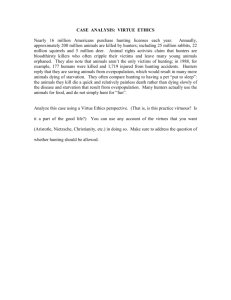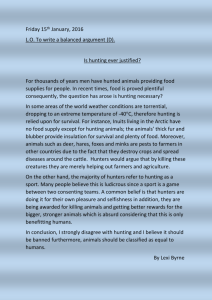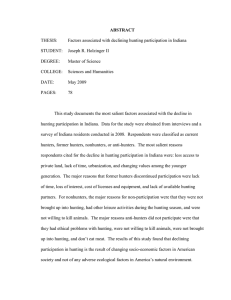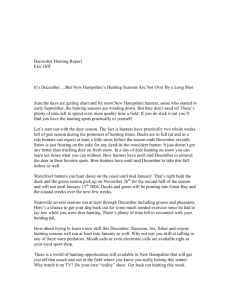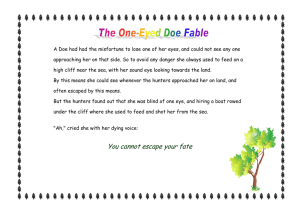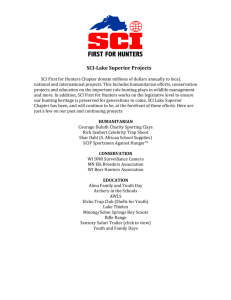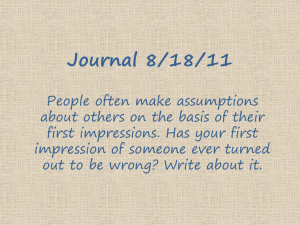Writing style assessment Environmental Science
advertisement
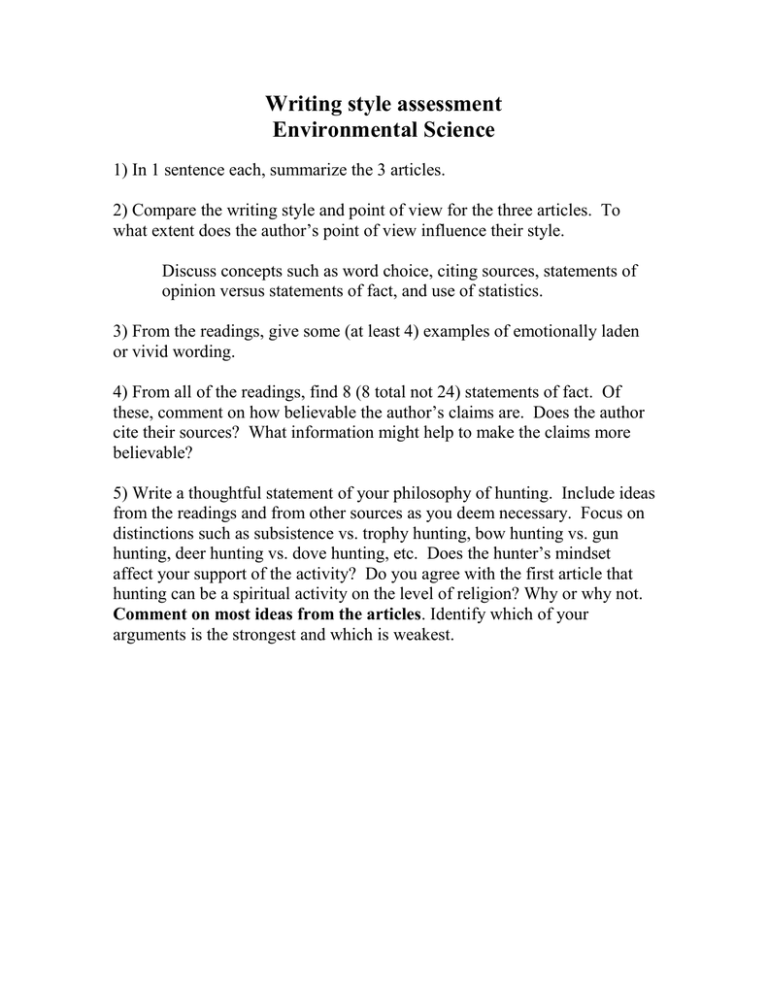
Writing style assessment Environmental Science 1) In 1 sentence each, summarize the 3 articles. 2) Compare the writing style and point of view for the three articles. To what extent does the author’s point of view influence their style. Discuss concepts such as word choice, citing sources, statements of opinion versus statements of fact, and use of statistics. 3) From the readings, give some (at least 4) examples of emotionally laden or vivid wording. 4) From all of the readings, find 8 (8 total not 24) statements of fact. Of these, comment on how believable the author’s claims are. Does the author cite their sources? What information might help to make the claims more believable? 5) Write a thoughtful statement of your philosophy of hunting. Include ideas from the readings and from other sources as you deem necessary. Focus on distinctions such as subsistence vs. trophy hunting, bow hunting vs. gun hunting, deer hunting vs. dove hunting, etc. Does the hunter’s mindset affect your support of the activity? Do you agree with the first article that hunting can be a spiritual activity on the level of religion? Why or why not. Comment on most ideas from the articles. Identify which of your arguments is the strongest and which is weakest. HUNTING AS A RELIGION "Hunting may lead people to have peak experiences. All the elements are there, from spectacular environmental settings to intense emotional excitement, to encounters with the deepest issues of life and death. Many hunters I know feel that ultimately hunting is their religion, but often do not admit this because of criticism from those who do not understand the hunter's soul. And what about the poor animals? the critics of hunting scream. Anyone can declare an animal to be special, even sacred. But a thing can become truly sacred only if a person knows in his or her heart that the object or creature can somehow serve as a conduit to a realm of existence that transcends the temporal. If hunting can be a path to spirit, unhindered by guilt, then nature has a way of making sure hunters feel compassion. "For those who have a religious experience all nature is capable of revealing itself as cosmic sacrality", concludes religion historian Mircea Eliade in his monumental review of spirituality, The Sacred and the Profane. It is precisely for this reason the Theodore Roosevelt, one of the greatest hunters and friends of wildlife in the twentieth century, often proclaimed that "all hunters should be nature lovers". [p. 35] "Nature hunters - 17 percent of the hunters Dr. Kellert interviewed said that they enjoy being outside and have a deep "affection, respect, and reverence" for nature. When asked, most will admit that hunting is much more than a sport. To them, ultimately it is a sacred act with as much as or more meaning than participation in organized religion. The first two types of hunters [meat hunters and recreational hunters] are understandable to most people. Their hunting motives are up-front and pragmatic. But nature hunters are a paradoxical mystery to many people. The nature hunter is someone whose deep, reverential feelings for nature are best described, ultimately, as love, and then they turn around and kill what they love. Many people interpret such behavior as sadistic or even pyschopathological. Dr. Karl Menninger, the noted humanistic psychologist, once declared hunters to be sadists. As a hunter and pychologist, I think he was dead wrong. In his later years Menninger came to agree with me, as we will learn later. In these times, when nature suffers from our indifference to it, and when countless humans suffer alienation from self and from nature, we need to better understand anyone who claims a deep, abiding love for nature and is willing to commit time, money and energy to conservation. Even if you are not a hunter, if you can read this book with an open mind you will come to know why nature hunters can say that for them, hunting is a spiritual act of love." [p. 19] "In modern times, invariably those fortunate hunters who come to know their animal kin are the ones who go on to found organizations to support the preservation of the species they hunt. In the final analysis, the emotion that drives these people is not guilt, as some might like you to believe, but love. At the root of any true feelings of sacredness there must be love, for it is the core emotion of self-value, which is the ultimate survival motivation of our species." [pp. 38-39] "The modern hunter, on the other hand, is challenged not so much by fear as by overcoming guilt. Most animals killed by hunters are not taken for protection or selfdefense, but for food, and perhaps a trophy. There is a special fondness in our hearts for wild things, and a hunter must work through guilt feelings to be successful. The more one learns about wild animals, the more one develops a fondness for them. Hunters also enjoy the overall act of hunting; being out in nature itself is a pleasure. When they are not successful; it is customary for hunters to share their kill with others, whether a tribal society or modern big-game dinner. And when the season is over, hunters often spend many hours helping to preserve habitats and restore species. The emotions that good hunters need to cultivate are love and service more than courage. The sentiments of the hunt then become translated into art, as much or more than trophies. Even the trophies of the hunter are art, for good taxidermy requires extraordinary artistic skill." [p. 29] TYPES OF HUNTERS Many wildlife managers feel that Yale professor Dr. Stephen Kellert's 1978 study of U.S. hunters and their attitudes and characteristics still mostly applies today in North America. He found three categories of hunters: - Utilitarian/Meat Hunters (43.8%) - Nature Hunters (17.7%) - Dominionistic/Sport Hunters (38.5%) The dominionistic/sport group is the one that the non- and anti-hunting public particularly dislike and often use to stereotype or negatively portray ALL hunters and hunting. UTILITARIAN/MEAT HUNTERS "Hunting to obtain meat was the most frequently cited primary reason, accounting for 43.8 percent of persons who hunted..." [p.413] Utilitarian/meat hunters were significantly more likey to have been raised or presently living in rural, open-country areas. Relatedly, utilitarian/meat hunters reported much greater experience with raising animals for either slaughter or nonslaugher purposes, and fathers employed in farm-related occupations. This hunting group included a disproportionate number of persons over 65 years of age and significantly more respondents earning less than $6,000." [p.414] "Utilitarian/meat hunters appeared to perceive animals largely from the perspective of their practical usefulness... The utilitarian/meat hunter viewed hunting as a harvesting activity and wild animals as a harvestable crop not unlike other renewable natural resources." [p.414] NATURE HUNTERS "Hunting for the purpose of close contact with nature was the... cited primary reason for hunting, accounting for some 17.7 percent of those who hunted... Demographically, nature hunters included significantly more persons under 30 years of age and far fewer over 65. These age characteristics may suggest possible trends in motivation for hunting. Nature hunters were also of higher socioeconomic status, as indicated by more collegeeducated respondents and more fathers employed in professional and business-executive occupations. Nature hunters reported by far the most adult and childhood wildlife interest, more backpacking and camping-out experience, and more birdwatching activity. Importantly, nature hunters had far higher knowledge-of-animals scale scores particularly in comparison to dominionistic/sport hunters." [p.414] [Nature hunters also] "...indicated strong concern and affection for all animals... [However this affection is] ...somewhat generalized and not specifically directed at pet animals or manifest in the feeling of "loving" animals. The desire for an active, participatory role in nature was perhaps the most significant aspect of the nature hunter's approach to hunting. The goal was the intense involvement with wild animals in their natural habitats. Participation as a predator was valued for the opportunities it provided to regard oneself as an integral part of nature. The hunt was appreciated for its forcing of awareness of natural phenomena organized into a coherent, goal-directed framework." [p. 415] DOMINIONISTIC/SPORT HUNTERS "Dominionistic/sport hunters constitute 38.5 percent of all those who hunted... They were significantly more likely to reside in cities, and to have been in the armed forces. Additionally, they differed from utilitarian/meat hunters in reporting far less experience raising animals for a product, and from nature hunters in reporting significantly less backpacking and birdwatching activities. One outstanding characteristic was their low scores on the knowledge-ofanimals scale. Interestingly, only anti-hunters, of all animal activity groups studied, had equally low knowledge scores." "...It appeared that competition and mastery over animals, in the context of a sporting contest, were the most salient aspects of the dominionistic/sport hunter's interest in the hunting activity. This group did not reveal strong affections for animals." [p.416] "The hunted animal was valued largely for the opportunities it provided to engage in a sporting activity involving mastery, competition, shooting skill and expressions of prowness. ...They were not items of food but trophies, something to get and display to fellow hunters. For the dominionistic/sport hunter, hunting was appreciated more as a human social than as an animal-oriented activity." [p.416-417] ------Stephen Kellert, "Attitudes and Characteristics of Hunters and Antihunters" (Transactions of the Forty-third North American Wildlife and Natural Resources Conference, 1978). pp.412-423. Learn the Facts about Hunting society--- --------Humane Fall is the time when forest greens begin to blaze orange, as hunting seasons open around the country. Each year, hunters kill more than 100 million animals, and while individual reasons for hunting vary, the industry that promotes and sustains hunting has just one motive: profit. According to the International Association of Fish and Wildlife Agencies, America's 14 million hunters spend $22.1 billion each year for guns, ammunition, clothing, travel, and other related expenses. To justify hunting to a society ever more concerned about wildlife—including its conservation and humane treatment—the industry intensively promotes a set of tired myths. Learn the facts behind these myths. Isn't hunting a worthy tradition because it teaches people about nature? There are many ways to learn about nature and the "great outdoors." At its best, hunting teaches people that it is acceptable to kill wildlife while learning about some aspects of nature. However, the very essence of sport hunting is the implicit message that it's acceptable recreation to kill and to tolerate the maiming of wildlife. Even those who claim that wounding and maiming is not the intent of hunting cannot deny that it happens. It is folly to suggest that we can teach love, respect, and appreciation for nature and the environment through such needless destruction of wildlife. One can learn about nature by venturing into the woods with binoculars, a camera, a walking stick, or simply with our eyes and ears open to the world around us. Does hunting help create a bond between father and son? We do not know, but there are countless recreational and other activities that can strengthen the parent/child bond. Generally speaking, bonding has less to do with the activity and more to do with whether the parent and child spend significant, concentrated, and loving time together. Yet the particular recreational activity is also important, because it can send a moral message to the child about what constitutes acceptable recreation. Hunting as a form of family entertainment is destructive not only to the animals involved, but also to the morals and ethics of children who are shown or taught that needless killing is acceptable recreation. The HSUS rejects the notion that a relationship of love and companionship should be based on the needless killing of innocent creatures. Killing for fun teaches callousness, disrespect for life, and the notion that "might makes right." Isn't hunting a popular and growing form of recreation? No. The number of hunters has been steadily declining for decades. According to the U.S. Fish and Wildlife Service, there were 15 million licensed hunters in the U.S. in 2000, compared with 15.6 million in 1993, 15.8 million in 1990, and 16.3 million in 1980. This drop has occurred even while the general population has been growing. Currently only 5.4% of Americans hold hunting licenses. Hunters claim their numbers are growing to give the impression that recreational killing is acceptable. The facts are that more and more hunters are giving up hunting because it is no longer a socially acceptable activity. What are state wildlife agencies doing to maintain interest in hunting? Most states actively recruit children into hunting, through special youth hunts. Sometimes these youth hunts are held on National Wildlife Refuges. Some states have carried this concept even further, and hold special hunter education classes to recruit parents and their children. In addition to encouraging children to buy licenses and kill animals, the states are reaching out to women as well. If enough women and children can be converted into hunters, the state agencies can continue business as usual. Isn't hunting a well-regulated activity? No. While there are many rules which regulate hunting activities, enforcing the regulations is difficult, and many hunters do not abide by the rules. It has been estimated that twice as many deer are killed illegally as are killed legally. Hunters will sometimes kill a second deer because it has bigger antlers or "rack" than the first. In addition, duck hunters often exceed their bag limits or kill protected species because most hunters cannot identify the species of ducks that they shoot—especially not at a half hour before sunrise, when shooting begins. Secret observations revealed by ex-duck hunters demonstrate that illegal practices and killing permeate this activity at all levels. Aren't animals protected through "bag limits" imposed by each state? Those species favored by hunters are given certain protection from over-killing—killing so many as to severely limit the population—through what are known as "bag limits." However, hunting of some species is completely unregulated, and in fact, wanton killing is encouraged. Animals such as skunks, coyotes, porcupines, crows and prairie dogs are considered "varmints," and unlimited hunting of these species is permitted year-round in many states. At the base of this is the notion that these animals are simply "vermin" and do not deserve to live. Hunters frequently write and speak of the pleasure in "misting" prairie dogs—by which they mean shooting the animals with hollow-point bullets that cause them to literally explode in a mist of blood. Moreover, hunters' influence on state and federal wildlife agencies is so strong that even bag limits on "game" species are influenced as much by politics as by biology. Many states, with the sanction of the federal government, allow hunters to kill large numbers (20–40 per day) of coots and waterfowl such as sea ducks and mergansers, for example, despite the fact that little is known about their populations and their ability to withstand hunting pressure, and the fact that these ducks are certainly not killed for food. This killing is encouraged to maintain hunter interest, thereby sustaining license sales, because the decline in other duck species has resulted in some limitations on numbers that can be killed. Isn't it more humane to kill wildlife by hunting than to allow animals to starve? This question is based on a false premise. Hunters kill opossums, squirrels, ravens, and numerous other plentiful species without any notion of shooting them so that they do not starve or freeze to death. Many species are killed year round in unlimited numbers. In addition, many animals that are not hunted die of natural starvation, but hunters do not suggest killing them. While it is true that any animal killed by a hunter cannot die of starvation, hunters do not kill animals based on which ones are weak and likely to succumb to starvation. Hunters who claim they prevent animals from suffering starvation are simply trying to divert attention from an analysis of the propriety of killing wildlife for fun. Aren't most hunts to limit overpopulation and not truly for recreation? No. Most hunted species are not considered to be overpopulated even by the wildlife agencies that set seasons and bag limits. Black ducks, for instance, face continued legal hunting—even on National Wildlife Refuges—despite the fact that their populations are at or near all-time lows. If hunters claim that they hunt to prevent overpopulation, then they should be prepared to forgo hunting except when it really is necessary to manage overpopulated species. This would mean no hunting of doves, ducks, geese, raccoons, bears, cougars, turkeys, quail, chuckar, pheasants, rabbits, squirrels, and many other species. What's more, hunters are usually the first to protest when wolves, coyotes, and other predators move into an area and begin to take over the job of controlling game populations. The State of Alaska, for example, has instituted wolf-control (trapping and shooting) on the grounds that wolf predation may bring caribou populations down to a level that would limit the sport-hunting of caribou. Finally, hunters kill opossums, foxes, ravens, and numerous other plentiful species without the pretension of shooting them so that they do not starve or freeze to death. Is hunting to prevent wildlife overpopulation usually effective? No. Wildlife, to a large degree, will naturally regulate its own populations if permitted, eliminating any need for hunting as a means of population control. Discussions about supposed wildlife overpopulation problems apply primarily to deer. Hunters often claim that hunting is necessary to control deer populations. As practiced, however, hunting often contributes to the growth of deer herds. Heavily hunted states like Pennsylvania and Ohio, for instance, are among those experiencing higher deer densities than perhaps ever before. When an area's deer population is reduced by hunting, the remaining animals respond by having more young, which survive because the competition for food and habitat is reduced. Since one buck can impregnate many does, policies which permit the killing of bucks contribute to high deer populations. If population control were the primary purpose for conducting deer hunts, hunters would only be permitted to kill does. This is not the case, however, because hunters demand that they be allowed to kill bucks for their antlers. Does hunting ensure stable, healthy wildlife populations? No. The hunting community's idea of a "healthy" wildlife population is a population managed like domestic livestock, for maximum productivity. In heavily hunted and "managed" populations, young animals feed on artificially enhanced food sources, grow and reproduce rapidly, then fall quickly to the guns and arrows of hunters. Few animals achieve full adulthood. After 20 years of heavy deer hunting at the Great Swamp National Wildlife Refuge in New Jersey, for example, only one percent of the deer population lived longer than four years, and fewer than ten percent lived longer than three years. In a naturally regulated population, deer often live twelve years or longer. Though hunting clearly kills individual animals, can hunting actually hurt wildlife populations? Yes. Hunters continue to kill many species of birds and mammals (e.g., cougars, wolves, black ducks, swans) that are at dangerously low population levels. While hunting may not be the prime cause of the decline of these species, it must contribute to their decline and, at a minimum, frustrate efforts to restore them. Even deer populations may be damaged by hunting pressure. Unlike natural predators and the forces of natural selection, hunters do not target the weaker individuals in populations of deer or other animals. Rather, deer hunters seek out the bucks that have the largest rack. This desire for "trophy sized" bucks can and has had detrimental effects on the health of deer herds. First, hunting can impact the social structure of a herd because hunters kill the mature males of a herd and create a disproportionate ratio of females to males. It is not uncommon to find a herd that has no bucks over the age of three. Second, genetically inferior bucks may be left to propagate the species, thereby weakening the overall health of the herd. Because hunters largely want to shoot only bucks, hunting may cause artificial inflation of deer populations. When these populations reach levels that available habitat cannot support, increased disease and starvation may be the result. We don't understand the full effect of hunting on wildlife behavior or health because wildlife agencies will not conduct the studies necessary to find the answers (e.g., "spyblind" observations of duck hunting, in which undercover authorities secretly observe hunters). Is hunting for food a good way to save money on grocery bills? Almost never. When all costs are considered (i.e., license fees, equipment, food, lodging and transportation), hunting is not an economical way to provide food. Statistics gathered by the University of Maryland's Extension Service revealed that hunters spent more than $51 million to kill 46,317 deer in Maryland in 1990, approximately $1,100 for each deer killed. Assuming that the meat of each deer killed was preserved and eaten, and that each deer provided 45 lbs. of meat, the cost of venison in 1990 in Maryland was $24.44 per pound. For most hunted animals, such as ducks, doves, rabbits, squirrels, and crows, among others, use for food is now minimal, and the expense of equipment far outweighs the value of any food that is obtained. For the vast majority of hunters, hunting is recreation, not a means of gathering food.
